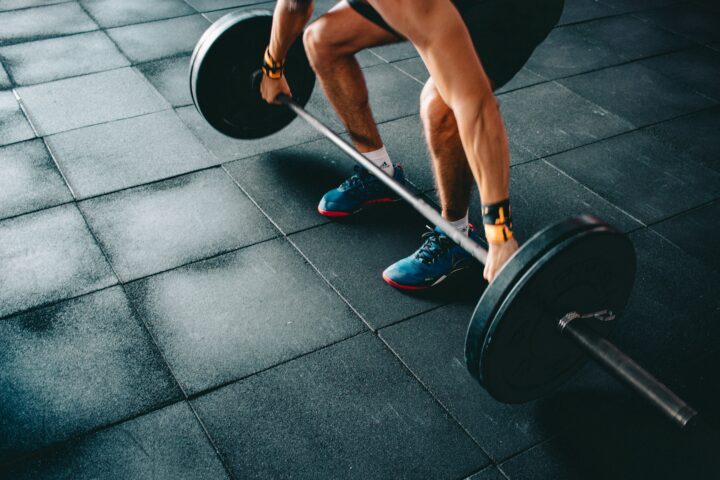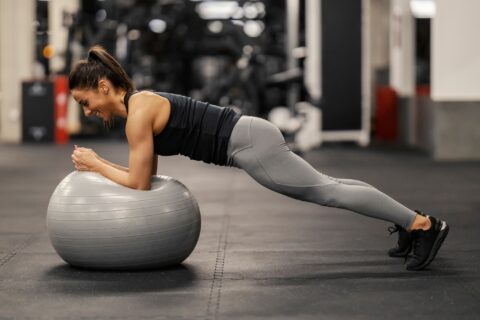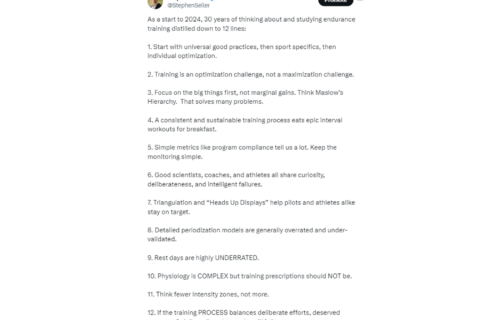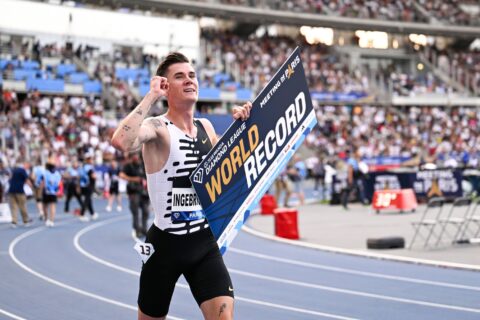World-leading environmental physiologist Dr. Stephen Cheung shows how to practice heat training in your own home and how to incorporate it into your annual training schedule.
Video Transcript
Intro 00:09
Welcome to Fast Talk Laboratories, your source for the science of endurance performance.
Dr. Stephen Cheung 00:20
Welcome to today’s workshop, I’m Dr. Steven Cheung, and I’m a Professor of Kinesiology at Brock University in Canada. Today’s workshop, we’re going to focus on implementing heat training in a practical way. Now most of us do not have access to a research lab and an environmental chamber like I have in my lab. We also don’t have the ability to access complex equipment to monitor our core temperature, and also to really understand how much heat we are loading our body with. So today’s workshop, we’re going to focus on how we can practically implement heat training, and also some of the things we should be thinking about as we implement heat training into our actual overall year long training schedule. So while most of us don’t have access to a world class research lab in a really nice environmental chamber like I do, most of us do have an indoor bike, indoor setup, and also a lot of clothing. So the question becomes, can we heat adapt by training indoors in a normal room temperature by piling on a lot of clothes? This isn’t a new idea, but this has been the topic of a number of studies in the last couple of years in a very controlled fashion.
Carsten Lundby’s 2021 Study on Heat Training
Dr. Stephen Cheung 01:43
So let’s take a look at this one by Carsten Lundby that came out in 2021, and again, this was the exact question they were asking. Can you – we know you can traditionally heat adapt by exercising in a hot environment wearing normal clothing. The question really is, “Can we replicate and achieve the same level of heat adaptation by training in a normal room temperature, but piling on a lot of clothes?” In this case, it was with 19.5 degrees Celsius and fairly low relative humidity, but with a lot of clothing. And they also had a third condition of that same suit condition with 19.5 degree room temperature with heavy clothing. But afterwards, they also sat in a hot tub for 30 minutes with the idea that you’re going to have extra heat loading. So overall, there were 34 participants split up into the three groups, they perform 10 days of heat adaptation, and heat adaptation exercise was pretty easy. It was 50 minutes at a fairly light workload each day.
Dr. Stephen Cheung 02:51
What did they find? Well, ultimately, they found in terms of physiological responses, identical to the responses of all three groups in that they all achieved heat-out-of-patient, the classic symptoms of a decreased core and exercise temperature at rest and at exercise. Also the classic sign of a lower resting and exercise heart rate. The interesting thing is in all three groups, they did find a small but significant increase in hemoglobin mass. I’ve talked about this in previous workshop, looking at a much longer heat-out-of-patient program of five weeks. But it’s interesting here that we saw it in a much shorter traditional, roughly two weeks of heat adaptation.
Dr. Stephen Cheung 03:41
Now let’s look at the actual performance changes over the three groups. So what we have in this graph is the before and after results from, in terms of average power on the vertical axis for each of the three groups: the heat, the suit, and the suit plus hot water immersion before and afterwards, and this was done in 35 degrees Celsius. And this was trying to achieve as much work or power output as you can over 30 minutes. Just like we saw in the physiological responses, we saw the same consistent magnitude of improvement in time trial performance in all three groups after 10 days. They all improved about 9% in terms of their average power, and again, interestingly, even with the additional heat load provided by the hot water immersion, and this was on top and beyond what they were doing with exercise, there was still no improvement.
Analysis of the Results of Lundby’s Study
Dr. Stephen Cheung 04:44
One of the theories why this may be is that the participants were very well trained, so they may have already hit a ceiling effect that once you hit a certain amount of heat stress, having more isn’t going to necessarily benefit you more. So this study overall was really interesting for a few reasons. The first is, it shows that you can have a poor man’s heat adaptation by simply using a lot of clothes, and specifically by bundling up and performing exercise indoors, and probably also with minimal airflow. So instead of turning on the fan, you might have the fan much lower, or you might even turn it off, you’re going to achieve heat stress in your body, and that is similar to exercising in a hot environment. So that is really good news, it shows that most of us can achieve heat adaptation just in our own training environments at home. The other thing, the caveat is, you know, more isn’t necessarily better, right? This study shows that the hot water immersion addition didn’t help, and again, that’s probably because you’re going to hit a ceiling of heat adaptation. So don’t get into this trap of thinking a little is good, some more must be better. So that you always want to be training as hot or getting your body temperature as hot as possible. That can actually come back to bite you, and it’s probably not necessary for improvement anyway. So we have seen that it’s quite possible to heat adapt by putting on a lot of clothing indoors and training there. Can you do that outdoors? Can you just wear a lot of clothing when you are going out for a ride? And I would hazard to say that it’s probably not going to be as effective. You’re not going to get the same strong thermal stimulus that you do indoors when you’re riding outdoors with clothing, and that is because you’re generating a lot of airflow and a lot of convective heat loss, when you’re riding at 30 kilometers an hour, that you are simply not able to have that same strong thermal stimulus outdoors. So I would say wearing a lot of clothing, and riding outdoors, you’re only going to really get significant heat adaptation and heat stimulus, if it’s already very, very hot outside,so on the warm is summer days already. So keep that in mind. If you are going to heat train, it is probably best to do it on an indoor environment.
Do You Actually Need to be Exercising to Heat Adapt?
Dr. Stephen Cheung 07:26
So the next question to ask is, do you even need to be on your bike? Do you actually need to be exercising the heat adapt? We know when you exercise, you’re generating a lot of heat internally. What if you were generating or kind of receiving that heat from outside sources? Such as if you were sitting in a hot tub, or if you’re sitting in a sauna, and this was the focus of a study that was very, very logistically challenging and really well done and just came out in 2022 from a good friends of mine in New Zealand from Jim Carter’s lab. What they looked at were three heat adaptation conditions. One was your traditional exercise and a warm environment. The next one was a hot tub condition, so passive heating in 40 degrees Celsius water. And then the third condition was again, passive exposure in a sauna, 55 degrees Celsius, 52% relative humidity. The common thing with all of the heat adaptation was that the core temperature target was the same at raising the body temperature by one and a half degrees Celsius each day. And this was done over five days, and this was also compared to a control emerging group where there was no heat stimulus of 36 degrees Celsius water immersion.
Dr. Stephen Cheung 08:54
Now, why was this logistically really challenging? They had the same participants do all four conditions. And they had about a four week washout period in between. So this required over really about four to five months of dedicated time for each participant, so you can imagine how challenging this was. So they looked at two things; they looked at the magnitude of adaptation over those five days, and they also looked at the rate of increase. How rapidly the heat adaptation changes occurred over those time, and they looked at the hematological. They looked at blood parameters, and then again, they looked at things like heart rate and things like color temperature values. So what the researchers ultimately found was that all three forms of heat adaptation were equally effective in driving change in your body and getting you heat adapted. We did see a slight difference in terms of plasma volume in that the exercise group did have a slightly higher amount of increase in plasma volume than the other three groups. However, in core temperature, this three heat adaptation groups were all equally effective over the days of heat adaptation and driving down core temperature at rest by about point two degrees Celsius. In contrast to temperate water immersion, the control condition as expected had no difference in core temperature. We also saw the same kind of pattern in heart rate response.
Dr. Stephen Cheung 10:34
So ultimately, this was a really interesting study, because it really supports the idea that heat is, heat, is heat. So don’t get obsessed about what is the best individual method of core temperature increase. All that is important is the drive your core temperature up. Your body doesn’t really care how that he is achieved as long as you get sufficient heat stimulus.
How to Practically Apply Heat Training
Dr. Stephen Cheung 11:02
So if we’re now looking at how to practically apply this knowledge, it shows that if you can, sure go ahead and exercise in a hot environment, and that is going to be the most time efficient for you. But if that is not possible, or if that is, for example, during a rest phase of your training cycle, you know, exercising is not essential. You can achieve heat adaptation, again, and in other formats such as sauna and hot water immersion. So that is really good news as we are kind of developing our overall “how to implement heat training”, we can be a lot more versatile, and not just focus strictly on having to exercise in a hot environment.
The Big Question: How Do We Accurately and Reliably Measure Core Temperatures?
Dr. Stephen Cheung 11:51
Now the big question for most of us is how do we accurately and reliably measure core temperature, whether we are training in our indoor environment or outdoors. We ideally want a non invasive, and reusable in a cheap way to measure core temperature. Now if we’re in my lab, I have all sorts of complex lab equipment to directly measure core temperature, I also have access to things like the gastrointestinal pills that you can swallow and it will give you a measure of core temperature, a direct measure. However, those units are disposable, they’re one use, and they’re quite expensive.
Dr. Stephen Cheung 12:35
To get past all of these limitations in 2020, a group came out with the core body temperature, non invasive monitor, and it is a small kind of white disc that you strapped to your heart rate strap and it goes against your chest. The way it works is that it doesn’t just measure skin temperature, it actually measures heat flux, so the amount of heat moving from your body out to the environment, and then it’s from that value that you actually calculate the internal core temperature. So this came out in 2020, and it has been used by a lot of pro cycling teams. In 2021, the first independent validation study came out, so we’ll talk a little bit about the values that were found there and some of the ideas that was found in that study.
Measuring Validity and Reliability
Dr. Stephen Cheung 13:33
The study by Verdale tested the two things: they tested the validity of this system, and also the reliability. So a primer and what we mean by those two terms, the validity is if you are actually accurately measuring something. So as an example, if you are trying to measure the altitude, the height of Mount Everest, you want it to be actually accurate and record 1,848 meters. The second concept is reliability. Reliability is if you get the same measurement twice if you did a measure twice, does it come out the same? So the ideal system is both accurate and reliable. Not only is it going to actually tell you the correct value, it is going to tell you the correct value each time. So the Testis, they had one study or one set of trials where it was a steady state exercise at 90% of ventilatory threshold one (VT1) for 60 minutes in a temperate environment, and this was repeated twice and they were using this test to look at the reliability.
Dr. Stephen Cheung 14:48
Then, they also looked at the accuracy by really having another hot condition. They wanted to look at the unit not just when it’s in – it’s in a kind of a moderate heat stress, but in a very high heat stress environment. So, this was done in a hot environment of about 31 degrees Celsius, this was done at a pretty high intensity, and it was also intermittent. So it was 10 minutes on, a brief break, and then 60 minutes on, a brief break, another 15 minutes on. They were using this to look at a really high heat stress. They found that overall, there was pretty good reliability, indeed, very good reliability with the core, noninvasive unit. In that when you compare the results of the two temperate trials, there was very, very little difference between the two, and that the mean bias was indeed only .02 degrees Celsius, so it was very good in terms of reliability. What happens with validity? What happens when you have the non-invasive core body unit compared against rectal temperature, which is obviously direct, and invasive, but it’s also the golden standard of what is used in research.
Dr. Stephen Cheung 16:07
The findings there weren’t as promising in that the researchers found relatively poor validity with the core body monitor, and it was actually kind of in a sense, the worst of all worlds. When the actual rectal temperature and thermal stress was relatively low, the core body monitor actually tended to overestimate the core temperature. So for example, if you were actually at an rectal temperature of 37.5, the core non-invasive unit tended to read higher 37.8, 37.9 for example. Then you got the flip problem, when you got really hot when your body temperature was getting 38.5. and above, in that the core temperature measured by rectal temperature was actually quite high. But, the core non invasive body monitor actually underestimated it. So you kind of have the worst of all worlds, when you are kind of just in a sense riding along not overly hot, the core non-invasive unit was reading overly high. Then, when you were really thermally stressed, the core non-invasive body unit was reading low. So the researchers found that in over 50% of the measurements, there was more than a .3 degrees Celsius disparity of the core non-invasive unit with actual rectal temperature.
Can we Rely on Wearable and Non-Invasive Systems?
Dr. Stephen Cheung 17:47
This does raise a few questions of whether we should really be relying on wearables and non-invasive systems. I believe, ultimately, we will get there with the non-invasive units that can really accurately and reliably measure core temperature. But right now, you know, it is still a work in progress. So how should we use if we are using something like the core, non invasive body monitors, I would say err on the side of caution, don’t overly drive your body temperature high and use those values to stay within about 38.0 to 38.5. If you’re using a core. That is really about the threshold that you need for heat training, and again, given the current inaccuracy in the core, you don’t really want to be going much above that, because if the core unit is saying 38.5, it’s likely that your actual body temperatures is significantly higher than that. So you really want to err on the side of caution if you are using a core, at least as of this, this workshop being recorded in early 2022.
How Are We Going to Periodize Heat Training?
Dr. Stephen Cheung 19:13
So ultimately, how are we going to periodize heat training? To do this, we’ll go back to the Slivka study that I talked about in the accompanying heat training physiology workshop. To remind you what we found there, we found that it wasn’t necessarily possible to optimize both heat training and actual physical training at the same time. If you’re dosing yourself with heat, your capacity to actually physically train is blunted. So keep that in mind as you’re planning out your periodization. You want to plan your heat training in a couple of weeks where the aerobic gains from training is not the absolute priority. So, what for most of us mean, it’s going to mean kind of an early base or early build period where you can afford to step off the gas a little bit in terms of your training. I would also recommend not doing heat training during rest weeks, and that is because with rest weeks, that is the focus you want to be resting maximally. Remember, heat is a stressor on your body, so if you are trying to rest, but you are loading up with heat, you’re not really optimizing your rest either.
Dr. Stephen Cheung 20:29
The other thing we can take away from what we’ve talked about so far in this workshop, is that the good news is any mode is okay, it seems we can do it quite simply by indoor training with a lot of clothing. Or if we have access to a sauna or a hot tub, that will also work too.
Once you have Heat Adapted, How long Does it last?
Dr. Stephen Cheung 20:50
So then, once your heat adapted, how long does it last? The news is pretty good from the limited studies have been done today, and this was summarized by a meta-analysis by my friend Hind Donin from the Netherlands and 2018. Looking at both core temperature and heart rate adaptations, it seems that once you’re adapted, they do last quite a long while, again, there were only about eight to nine studies that were focusing on this idea to begin with. But, summarizing those studies and integrating them together, it seems that heat adaptation, once you’ve achieved it, is lost at a fairly slow rate of only about two and a half percent of the gains being lost per day that you’re not adapting the heat. So we see that once were heated up, and we can keep it pretty well. Obviously, the longer we’re heat adapted, probably the better it is in terms of maintaining it. Also, if you’re starting to fade in terms of your heat adaptation, you want to reintroduce it, it seems it’s pretty rapid that with core temperature and heart rate, again, limited studies, but it suggests that you can reintroduce maximal heat adaptation in four to five days. We don’t really know what happens with performance. None of these studies have really looked at performance, they’ve looked at physiology.
What Can we do With This Advice from a Practical Perspective?
Dr. Stephen Cheung 22:24
So what can we do with this advice from a practical perspective? Iit would suggest that if we are for example, inducing heat adaptation during a base aerobic kind of period, early in our training year, we can actually keep it quite effectively for the bulk of the year, and this can be done by just for example, one to two bouts of heat training, whether it’s sauna, whether it’s in the hot tub, or riding in a hot environment with a lot of clothing, just once, maybe twice a week. Also, if we are really spending a lot of time without kind of heat stress after we become induced with heat adaptation, it seems again, we can reintroduce it quite quickly. So these are all pretty positive things we can take away that we can maintain heat adaptation for quite a while once we have achieved it, and quite simply by just periodic doses of wants to maybe twice a week.
Take Home Message: How To Implement Heat Training
Dr. Stephen Cheung 23:34
So let’s summarize some of the main points from this workshop. Hopefully, the main message I’ve imparted is that you can’t be willy-nilly in your heat training, you need to plan it systematically, both day to day and also in terms of your overall training plan. You need an adequate and appropriate stimulus. The good news is that we seem to be equally effective, as long as we drive our body temperature up, regardless of whether we’re doing that with exercise or with passively being exposed to heat like in a sana or a hot tub.
Dr. Stephen Cheung 24:09
We’ve also seen that there are challenges and caveats with really understanding the thermal load that we’re imposing on ourselves. The core, non-invasive body monitor is good, and it’s very promising, but at this stage in early 2022, it remains imperfect, so you really need to understand how to use it and some of its limitations. Again, we need to periodized within your schedule, but if you can induce heat adaptation relatively early, it seems you can maintain it throughout the year with quite easy regimen of maybe one to two exposures, to heat over a week for the remainder of the time that you want to maintain heat adaptation, and then even afterward to seems to fade fairly slowly. So that is really good news if we’re going to do heat adaptation early, we seem to be able to use it for the rest of the year quite effectively if we are smart about things. So those are all good, hopefully solid takeaways for you for how to implement heat training, whether you’re going to be competing in the heat or if you’re using it for strategic advantage, if you’re going to be competing it in a temperate environment. So as always, I’ve included the references to the scientific articles that I’ve discussed in this workshop.
Dr. Stephen Cheung 25:33
So at this workshop in this all this discussion on heat training, got you fired up to try it? Are you still cool to the idea? Love to hear from you. Please join us on Fast Talk Forums and discuss any ideas or any experiences that you have with heat training, and also whether you found it effective for temperate competitions. I’m Professor Stephen Cheung. Thanks for watching. We’ll see you soon.



